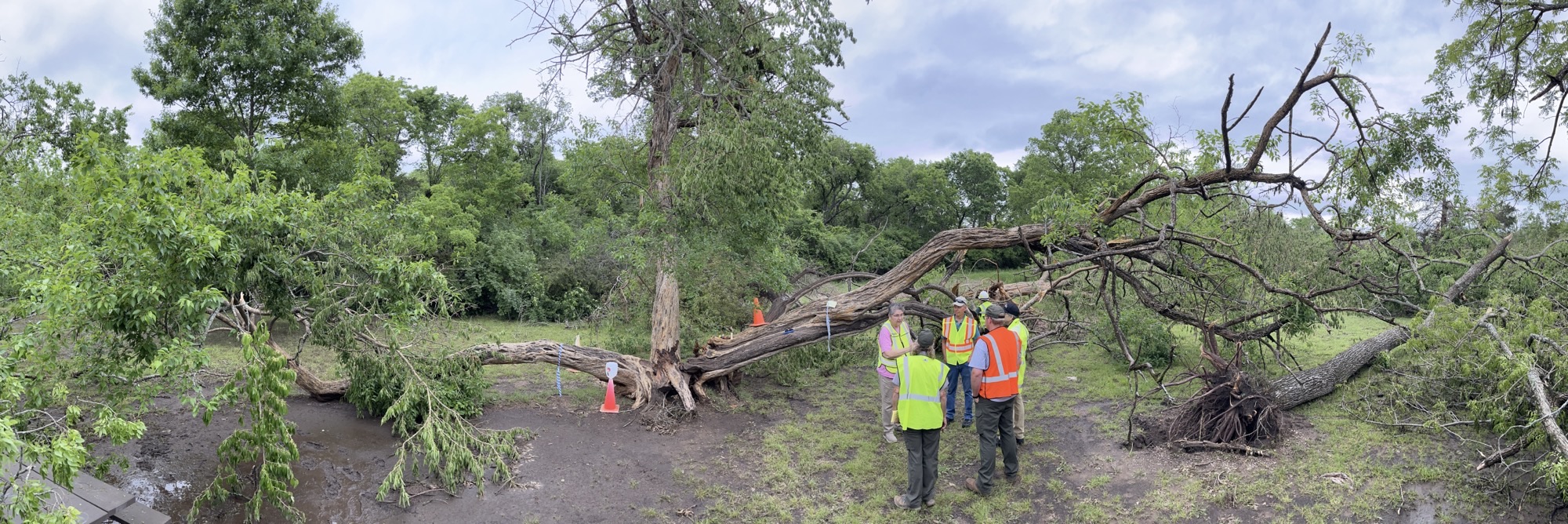News Release
You are viewing ARCHIVED content published online before January 20, 2025.
Please note that this content is NOT UPDATED, and links may not work. For current information,
visit https://www.nps.gov/aboutus/news/index.htm.

NPS Photo
|
Subscribe
|
Contact: Public Affairs
SULPHUR, Okla.– On April 27, a tornado touched down south of Veterans Lake in Chickasaw National Recreation Area. It traveled northeast for 1.4 miles and was .5 miles wide. Most trees in the tornado’s path were uprooted or had their canopies sheared off. Very few were left unscathed.“The trees in the park are a very important part of our historic cultural landscape,” said Acting Superintendent Devon Bradley, “Many of the trees were planted by the Civilian Conservation Corps (CCC) as part of their effort to transform a denuded resort landscape into a holistic place of great beauty, whose enduring recreational and scenic values our visitors still experience and appreciate today.”
Between 1933-1940 the CCC worked in Platt National Park (later to be incorporated into Chickasaw National Recreation Area) developing a series of landscapes—including spring pavilions, creek dams, swimming holes, wooded picnic grounds, hiking trails, a new road system, and campgrounds. Nicknamed “Roosevelt’s Tree Army,” the CCC initially focused on reforestation, but quickly evolved to include soil conservation and development of recreational park facilities. In Platt National Park, the CCC planted over 500,000 plants, including 60 tree species.
Perhaps the most iconic tree impacted by the tornado was the Monkey Tree. This unique Osage orange predates those planted by the CCC. At approximately 130 years old, this tree is beloved by the local community of Sulphur for its gangly limbs that generations of children have climbed and played on. While the Monkey Tree did sustain damage, experts say it will likely survive. Some of the large branches broke from the main stem and may not survive. Crews are going to attempt to save some of these branches by building cribbing under the limbs to support their weight and allow them to heal. During this period of healing, it will be closed to the public.
“The damage we received from the tornado reminds me of another famous tree in Oklahoma,” said Bradley. “The Survivor Tree is an American elm tree in the heart of downtown Oklahoma City that survived the Murrah Federal Building bombing, withstanding one of the worst terrorist attacks in our country.”
Saplings from the Survivor Tree have been transplanted at various sites across the state, including one tree which now resides at Travertine Nature Center in Chickasaw National Recreation Area. These trees remain as a symbol of resilience - changing and growing and persevering through adversity. In time, it is the park staff hopes that the Monkey Tree will extend its branches once more to embrace a new generation of children who will play under its canopy and swing from its branches.
For more information about Chickasaw National Recreation Area and for updates on park operations, visit https://www.nps.gov/chic/planyourvisit/conditions.htm or follow the park’s social media accounts, username ChickasawNPS, on Facebook, X, and Instagram.
About the National Park Service
More than 20,000 National Park Service employees care for America’s 429 National Parks and work with communities across the nation to help preserve local history and create close-to-home recreational opportunities. Learn more at www.nps.gov.

Last updated: May 6, 2024
